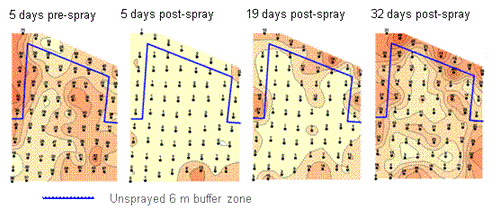Hundreds of different invertebrate species live within cropped fields, but fortunately, few ever become pests because they are killed by other invertebrates, their natural enemies. However, insecticides are toxic to most arthropods including the natural enemies and insects important as bird food.
With IPM, the aim is to maximise natural regulatory mechanisms and to only use insecticides when economic spray thresholds are exceeded. Control by natural enemies can be unpredictable within and between fields, therefore, along with our research partners, we measured the abundance and distribution of pest natural enemies from the field to landscape scales to identify which factors were controlling these patterns.
Our initial studies of natural enemies revealed that they were patchily distributed within fields but more were found around the outer 60m of the crop. This was because weed cover was often higher at the edge of fields holding some species, but also those species overwintering within the boundaries only penetrated this far into the crop. An application of dimethoate insecticide severely reduced most species and there was little recovery in the current season.
Figure 1: Impact of the insecticide dimethoate on the distribution of beetles

Of all the invertebrates occurring within fields, beetles are considered one of the most important groups of predatory insects because they are numerous, with species active throughout the year. Two studies were conducted to further investigate the extent to which beetles control pests and whether they are able to detect and concentrate their feeding in pest patches. Our work focused on cereal aphids because these pests readily occur and are easy to assess and on beetle spatial dynamics.
The distribution and abundance of invertebrates within a field may also be influenced by the non-crop habitats surrounding the field but also the composition of the landscape. Two further projects were conducted to investigate this: the 3D Farming project (2000-04) and re-bugging the system (2005-09).
Our interest in beetles stemmed from the research on beetle banks. These were originally developed as a way of beetles to spread more evenly and rapidly across large fields. A number of PhD studies supported by the Trust have further investigated their role in biocontrol and supporting wildlife.